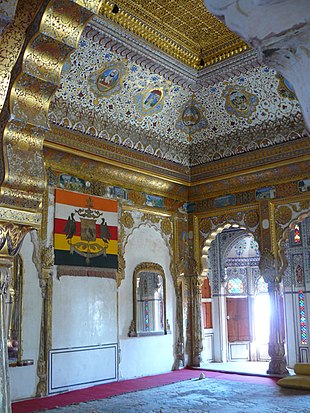Marwar
| Marwar / Jodhpur | |||||
| 1838-1949 | |||||
|
|||||
| Capital |
Mandore (1395–1450) Jodhpur (1450–1949) |
||||
| Form of government | Princely State | ||||
| surface | 91,420 km² | ||||
| population | 2,500,000 (1941) | ||||
| founding | 13th century | ||||
| resolution | April 7, 1949 | ||||
| State religion: Hinduism Dynasty: Rathore |
|||||
| Princely state of Jodhpur on a map from The Imperial Gazetteer of India (1907–1909) | |||||
| Hall in the Palace of Jodhpur | |||||
Marwar ( Hindi : मारवाड़ , Mārvāṛ ) was one of the princely states of the Rajputs in what is now Rajasthan ( British India ). Its first capital became Mandore around 1395 , which was replaced by Jodhpur around 1450 .
Founding legend
The principality was founded in the first half of the 13th century by the Hindu Rathore Rajputs, who were considered direct descendants of the ancient Gahadavala kings of Kannauj . But perhaps the corresponding poem about the founder of the state Sihaji (d. 1273) is only a later attempt to upgrade the line of ancestors. At least four Rathor- Rajas are mentioned in a local inscription as early as 997.
The state in the 15th century
The Raja Rao Chunda (ruled approx. 1383-1424) took control of Mandore , annexed Nagaur and Ajmer and was killed in a battle with the governor of Multan . His eldest son Ranmal (ruled 1427–1438) prevailed with the help of Mewar against his brothers Kanha (ruled 1423–1424) and Satta (ruled 1424–1427) and in turn helped the Raja of Mewar against his enemies was murdered while attempting to take power in Chittorgarh , its capital . Then Marwar fell under the control of the Maharana Kumbha of Mewar (ruled 1433–1468) until Ranmal's son Jodha (* 1416, ruled 1438–1488), after about 15 years of exile, seized power again and made peace with Mewar could close. He founded Jodhpur around 1459 and moved the capital there.
Under the rule of the Mughals
After the death of Maldev (reigned 1532–1562) there was a controversy for the succession, as a result of which Akbar I (reigned 1556–1605) conquered Marwar and the Rajas had to recognize the suzerainty of the Muslim Mughals of Delhi . Starting with Udai Singh (reigned 1583–1595) and Suraj Singh (reigned 1595–1619) they were z. B. as a military leader in the service of the Mughals. Gaj Singh I. (r. 1619–1638) was made viceroy of the Deccan and his son Jaswant Singh (r. 1638–1678) was for a time the leading Hindu dignitary at the court of the Mughals. His death caused the Mughal Mughal Aurangzeb (r. 1658–1707) to occupy the principality despite a later heir to the throne, which resulted in a 30-year guerrilla war between the Mughals and the Rajput clans over Marwar, until Ajit Singh (r. 1679–1724) through the peace with the new Mughal Mughal Bahadur Shah (r. 1707–1712) could take up his government.
The state from the 18th to the 20th century
In the course of the 18th century Marwar was due to succession disputes between Bijay Singh (r. 1752 / 72-1793) and his uncle Ram Singh († 1773) and the constant threat from the raids of the Marathas . For example, Bijay Singh was 1790/91 by the Marathas of Mahadji Sindia († 1795) devastatingly defeated in two battles and spent the rest of his days with women’s stories.
In January 1818, Marwar became a British protectorate under Maharaja Man Singh (r. 1803-1843) . Although the British colonial government had already banned widow burning , six women were burned at the stake after the death of Man Singh.
In 1941 the princely state had an area of 91,420 km² and 2.5 million inhabitants. On March 30, 1949, the Maharaja joined the Rajasthan Confederation , and on April 7, 1949, he joined India . On November 1, 1956, the princely state was dissolved.
See also
literature
- William Barton: The princes of India. With a Chapter on Nepal. Nisbet, London 1934, (Reprinted edition. Cosmo, New Delhi 1983).
- Andreas Birken : Philatelic Atlas of British India. CD-ROM. Birken, Hamburg 2004.
- Ian Copland: The princes of India in the endgame of empire, 1917-1947 (= Cambridge Studies in Indian History and Society. 2). Cambridge University Press, Cambridge et al. 1997, ISBN 0-521-57179-0 .
- RK Gupta, SR Bakshi (Ed.): Rajasthan. Through the ages. Volume 5: Marwar and British Administration. Sarup & Sons, Delhi 2008, ISBN 978-81-7625-841-8 .
- George B. Malleson: An historical sketch of the native states of India. Longmans, Green & Co., London 1875, ( digitized version ).
- Paul E. Roberts: India (= A Historical Geography of the British Dominions. Vol. 7, Part. 1-2). 2 volumes (Vol. 1: History to the End of the East India Company. Vol. 2: History under the Government of the Crown. ). Clarendon Press, Oxford 1916-1923, (Reprinted edition: Historical Geography of India. 2 volumes. Printwell, Jaipur 1995).
- Joseph E. Schwartzberg (Ed.): A historical atlas of South Asia (= Association for Asian Studies. Reference Series. 2). 2nd impression, with additional material. Oxford University Press, New York NY et al. 1992, ISBN 0-19-506869-6 .
Web links
- iiNet: Jodhpur (Princely State)
- Imperial Gazetteer of India
- http://www.uq.net.au/~zzhsoszy/ips/main.html
- http://www.nationmaster.com/encyclopedia/States-of-India
- http://www.worldstatesmen.org/India_princes_A-J.html
Individual evidence
- ^ Cf. Jenny L. de Bruyne: Rudrakavi's Great Poem of the Dynasty of Rāṣṭrauḍha. Cantos 1-13 and 18-20 (= Orientalia rheno-traiectina. 10, ISSN 0169-9504 ). Brill, Leiden 1968, p. 11.
- ↑ a b c Fredrick W. Bunce: Royal palaces, residences and pavilions of India. 13th through 18th centuries. An iconographic consideration. DK Printworld, New Delhi 2006, ISBN 81-246-0356-1 , p. 303.
- ↑ a b Ram A. Agarawala: Marwar murals. Agam Prakashan, Delhi 1977, p. 106.
- ↑ An older son named Prithvi Singh is said to have been poisoned by Aurangzeb at court.
- ↑ Rosemarie Noack: His highness makes you ask . In: Zeit Online , March 4, 2009.



